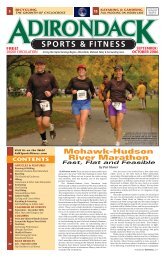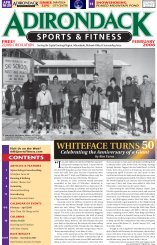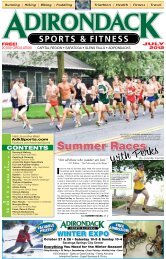Kids Running - Adirondack Sports & Fitness
Kids Running - Adirondack Sports & Fitness
Kids Running - Adirondack Sports & Fitness
Create successful ePaper yourself
Turn your PDF publications into a flip-book with our unique Google optimized e-Paper software.
www.Adk<strong>Sports</strong><strong>Fitness</strong>.com March 2006 7<br />
SWIMMING<br />
by Terry Laughlin<br />
My two previous articles on<br />
breathing in the September<br />
and December 2005 issues,<br />
covered fundamentals – how to keep from<br />
choking and the importance of focusing<br />
on the exhale. In this installment, we’ll<br />
aexamine the specific techniques of<br />
breathing in rhythm with your stroke.<br />
The three most common breathing technique<br />
errors I see among unskilled or<br />
uncoached swimmers include:<br />
1) Lifting the head for air. This hurts your<br />
body position and leads to use of the arms<br />
to “brace” or support the head’s weight,<br />
when they should be lengthening the<br />
body or “holding on to your place” in<br />
the water.<br />
2) Turning only the head for air. This awkward<br />
action increases strain and torque in<br />
the neck and spine, and hurts your form.<br />
3) Losing your front end. Having the lead<br />
hand collapse while breathing is almost<br />
universal among unskilled or unbalanced<br />
swimmers. When it happens you become<br />
less hydrodynamic and much of the<br />
propulsive potential of that stroke is lost.<br />
The best way to imprint an efficient<br />
breathing form – one that provides all the<br />
air you need and keeps your stroke long<br />
and efficient – is to practice the skating,<br />
underswitch and zipperswitch drills from<br />
the Total Immersion freestyle progression.<br />
But you can also improve your form with<br />
mindful swimming using whole-stroke<br />
practice of focal points that specifically<br />
address breathing mechanics. Here are<br />
those I practice most often myself.<br />
Breathe with your bellybutton. Not literally,<br />
but rolling to the air as if you intend<br />
to do so will help overcome number two<br />
above. You should attempt to feel as if you<br />
roll your body to the air and your head<br />
goes along for the ride. If you think of<br />
keeping your chin and sternum aligned –<br />
then allow your chin to travel a bit farther<br />
on its own – you ought to get ample body<br />
rotation and avoid the strain of just turning<br />
your head while your body remains<br />
Plenty of Air<br />
and a Smoother<br />
Freestyle<br />
prone. I also sometimes imagine that my<br />
breather is on the side of my rib cage, six<br />
inches below my armpit. If I take that part<br />
of my torso to the air, I always get plenty.<br />
Keep the top of your head down.<br />
Between breaths, your balance is best if<br />
you point your nose at the bottom and<br />
lead with the top of your head. While<br />
doing so, get a sense of having a laser<br />
beam, shining from the top of your head,<br />
at the leading edge of your “head-spine<br />
line.” You should keep that laser beam<br />
pointing straight to the horizon, or at the<br />
end of the pool, both between breaths and<br />
during your breath. You can work at this in<br />
three ways: 1) Keep the top of your head as<br />
close to the surface as possible, while<br />
rolling to breathe; 2) Press in the side and<br />
back of your head as you breathe; and 3)<br />
tuck your chin toward your shoulder as<br />
you breathe.<br />
Get taller as you breathe; stay tall as<br />
you come out of your breath. You’ll maintain<br />
far more momentum and speed during<br />
your breath, and get a more effective<br />
stroke following it, if you keep your leading<br />
hand forward, and in a good “gripping”<br />
position during your breath. To<br />
achieve this, concentrate on having your<br />
opposite hand continue to extend forward<br />
as you roll to breathe, and begin your<br />
stroke only as you begin to roll back down<br />
again. And the next stroke will be far<br />
stronger if you keep your fingers tipped<br />
down throughout. In virtually all unbalanced<br />
swimmers, the hand turns up<br />
(think of Diana Ross singing “Stop in the<br />
Name of Love”) during the breath, acting<br />
as a brace, not a gripper.<br />
May 18, 2006<br />
6:25 PM<br />
Empire State Plaza<br />
� ROLL TO AIR, STAY LOW<br />
AND STAY TALL.<br />
COURTESY OF TOTAL IMMERSION<br />
A Breathing-Skills Practice<br />
Swim a series of three sets of repeats,<br />
with each set lasting six to ten minutes.<br />
Choose any repeat distance from 25 to 100<br />
yards. To recover between repeats, do<br />
three (for shorter repeats) to six (if longer<br />
repeats) bobs, bubbling out as you bob<br />
underwater and getting air quickly and<br />
easily as you bob to the surface. You<br />
should rest for an additional one to two<br />
minutes between sets. Breathe every two<br />
to three strokes (not cycles) throughout.<br />
Swim the first round concentrating on<br />
breathing with your bellybutton. Swim the<br />
second round, concentrating on keeping<br />
the top of your head down. Swim the third<br />
round, concentrating on getting taller<br />
as you breathe. Which focal point helps<br />
the most?<br />
The fourth and final article in this<br />
series will be on breathing frequency and<br />
open-water breathing techniques in the<br />
June 2006 issue.<br />
Terry Laughlin is head coach of Total<br />
Immersion Swimming in New Paltz. This<br />
article is excerpted from a special e-book<br />
and mini-video on breathing skills to be<br />
published shortly. For more information,<br />
visit totalimmersion.net.<br />
W I L L Y O U B E T H E R E ?<br />
Entry materials will be mailed to the Team Captain of all<br />
organizations who participated in the 2005 event by April 1, 2006.<br />
If your organization didn’t participate last year, recruit your<br />
co-workers and form a team. Go to www.ghiwtc.com for entry<br />
forms or send an e-mail to ghiwtc@newkirk.com and entry materials<br />
will be mailed to you.













